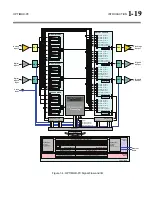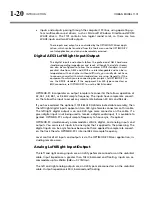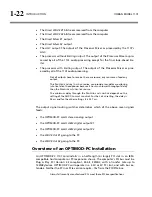
OPTIMOD-PC INTRODUCTION
1-33
Analog Telephone/Landline (PTT/Post Office Line)
Analog landline quality is extremely variable, ranging from excellent to poor. (For-
tunately, they are largely obsolete, having been replaced by digital links.) Whether
landlines should be used or not depends upon the quality of the lines locally avail-
able, and upon the availability of other alternatives. Due to line equalizer character-
istics and phase shifts, even the best landlines tend to veil audio quality slightly.
They will certainly be the weakest link in a DAB broadcast chain.
Slight frequency response irregularities and non-constant group delay characteristics
will alter the peak-to-average ratio, and will thus reduce the effectiveness of any
peak limiting performed prior to their inputs.
Location of OPTIMOD-PC in Digital Radio Service
At the Transmitter is Best
The best location for OPTIMOD-PC is as close as possible to the transmitter so that
OPTIMOD-PC’s AES3 output can be connected to the transmitter through a circuit
path that introduces no change in OPTIMOD-PC’s output bitstream. A high-quality
AES3 cable is ideal.
Where Access to the Transmitter is not Possible
Sometimes it is not possible to locate OPTIMOD-PC at the transmitter. Instead, it
must be located on the studio side of the link connecting the audio facility to the
transmitter. If the transmitter is not accessible, all audio processing must be done at
the studio, and you must tolerate any damage that occurs later.
If an uncompressed digital link is available, this is an ideal situation because such a
link will pass OPTIMOD-PC’s output with little or no degradation. However, such a
link is not always available.
If only a 32 kHz sample rate link is available, the sample rate conversion
necessary to downsample the audio will cause overshoots when
OPTIMOD-PC is operated at 20 kHz bandwidth because the sample rate
converter removes spectral energy. In this case, you can minimize over-
shoot by operating OPTIMOD-PC at 15 kHz bandwidth. (Set it from the
C
ONFIGURATION
tab in the I/O Mixer application.)
Unless the path is a digital path using no lossy compression, this situation will yield
lower performance than if OPTIMOD-PC is connected directly to the transmitter be-
cause artifacts that cannot be controlled by OPTIMOD-PC will be introduced by the
link to the transmitter. These artifacts can decrease average modulation by 2-4dB
and can also add noise and audible non-linear distortion. In the case of lossy digital
compression, this deterioration will be directly related to the bitrate. For an analog
path, the deterioration will depend on the amount of linear and non-linear distor-
tion in the path. In addition, there will be an unavoidable amount of overshoot
caused by asynchronous re-sampling (see page 1-31).
One strategy is to apply to OPTIMOD-PC’s output signal the same lossy compression
that the DAB transmitter would apply. If a digital link is available with sufficient bi-
trate to pass this compressed signal, it can then be passed directly to the DAB trans-
Summary of Contents for Optimod-PC 1101
Page 4: ......
Page 14: ......
Page 121: ...OPTIMOD PC OPERATION 3 1 Section 3 Operation Figure 3 1 The OPTIMOD PC Control Application...
Page 192: ...3 72 OPERATION ORBAN MODEL 1101...
Page 204: ......
Page 210: ......
Page 212: ...5 2 UNINSTALLATION ORBAN MODEL 1101...
Page 236: ......
















































